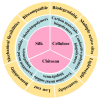Recent Advances in Natural Functional Biopolymers and Their Applications of Electronic Skins and Flexible Strain Sensors
- PMID: 33800960
- PMCID: PMC7961771
- DOI: 10.3390/polym13050813
Recent Advances in Natural Functional Biopolymers and Their Applications of Electronic Skins and Flexible Strain Sensors
Abstract
In order to replace nonrenewable resources and decrease electronic waste disposal, there is a rapidly rising demand for the utilization of reproducible and degradable biopolymers in flexible electronics. Natural biopolymers have many remarkable characteristics, including light weight, excellent mechanical properties, biocompatibility, non-toxicity, low cost, etc. Thanks to these superior merits, natural functional biopolymers can be designed and optimized for the development of high-performance flexible electronic devices. Herein, we provide an insightful overview of the unique structures, properties and applications of biopolymers for electronic skins (e-skins) and flexible strain sensors. The relationships between properties and sensing performances of biopolymers-based sensors are also investigated. The functional design strategies and fabrication technologies for biopolymers-based flexible sensors are proposed. Furthermore, the research progresses of biopolymers-based sensors with various functions are described in detail. Finally, we provide some useful viewpoints and future prospects of developing biopolymers-based flexible sensors.
Keywords: biocompatible; electronic skins (e-skins); flexible strain sensors; functionality; natural biopolymers.
Conflict of interest statement
The authors declare no conflict of interest.
Figures










References
-
- Li S., Xiao X., Hu J., Dong M., Zhang Y., Xu R., Wang X., Islam J. Recent Advances of Carbon-Based Flexible Strain Sensors in Physiological Signal Monitoring. ACS Appl. Electron. Mater. 2020;2:2282–2300. doi: 10.1021/acsaelm.0c00292. - DOI
Publication types
Grants and funding
- F2020202050/the Natural Science Foundation of Hebei Province
- 62004059, 11632004 and U1864208/the National Natural Science Foundation of China
- 2016YFE0125900/the Key Program for International Science and Technology Cooperation Projects of the Ministry of Science and Technology of China
- 2017-VII-0011-0106/National Science and Technology Major Project
- 20ZYJDJC00030/Science and Technology Planning Project of Tianjin
LinkOut - more resources
Full Text Sources
Other Literature Sources

